Landscape Restoration
Restoring California's Native Plants
One of the iconic images of California is the grass-covered hills – emerald green during a rainy winter, sparkling gold in the summer – dotted with oak trees. The oaks are native California plants, but – to the surprise of many – the grasses are not. Today the hills are covered almost entirely with annual grasses that were brought in by the Spanish with their livestock. The combination of invasive plants and large grazing animals devastated much of the native Californian landscape. These hills would have been covered by oak forests, perennial bunch grasses, and chaparral – tough, low-growing plants that can withstand 7 hot months a year without rain. More recently, unchecked urban development and ranching have continued the assault on California's native biodiversity.
Fortunately, pockets of native plants survived here and there, and the last 20 or 30 years have seen a growing interest in protecting and restoring California's native plants. The Santa Barbara Botanic Garden is devoted to California's native plants and is a treasure trove for anyone wanting to learn about or restore our heritage. The Las Pilitas Nursery in San Luis Obispo County grows and sells a wide variety of California native plants, and their web site is a font of useful information.
Our house sits on about 4 acres of extremely steep land. Half or a bit more is oak forest – a mix of California live oak and valley oak – that's in good condition with appropriate understory plants (coffeeberry, toyon, poison oak, etc.). But the remainder is, or was, typical grasslands with no native plants and little biodiversity. We decided to make a significant effort to restore some of the grasslands to chaparral. We started in Fall 2008, as the house was under construction. The before-and-after photos (Fall 2008 and Spring 2021) are followed by some of the details.
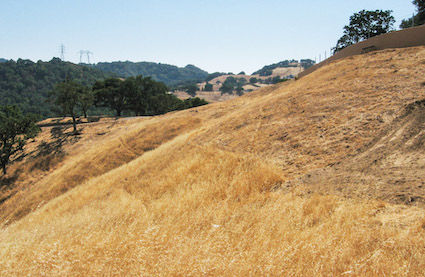
This is the steep hillside below the house. The annual grasses have all died at this time of year and are gold. Local fire regulations require cutting the grass near the road before the summer heat sets in.
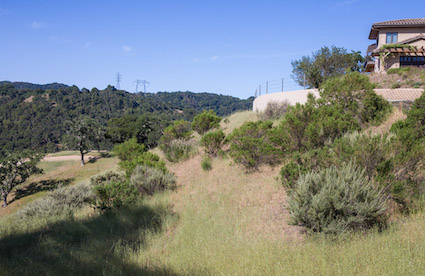
Coyote brush and California sagebrush interspersed with annual grasses that, in late spring, still have a touch of green.
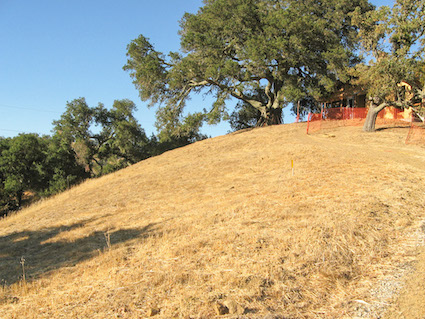
Hillside southwest of the house.
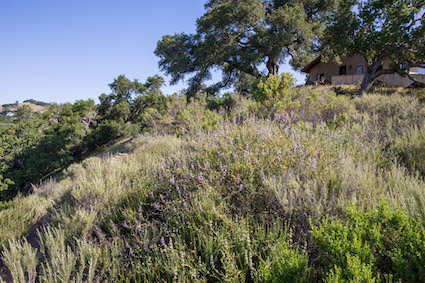
A variety of healthy chaparral plants are growing together to provide a near-continuous cover that shades out the grasses.
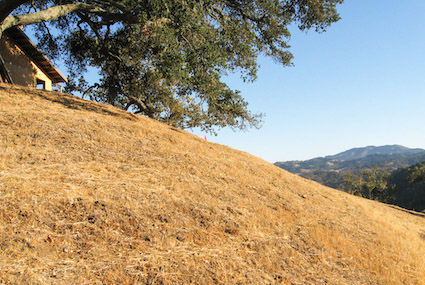
Hillside southeast of the house.
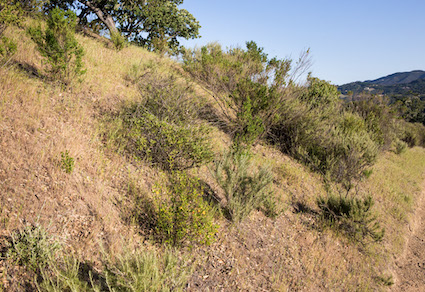
Continuous cover has been slower to develop here, so grasses remain. However, we've been able to encourage native bunch grasses that were already present at the expense of annual grasses. This hillside has quite a few native wildflowers early in the spring.
We began on the west side of the house by planting eight "resource islands" 10 feet in diameter. Each included some basic chaparral plants – California sagebrush, coyote brush, buckwheat, sticky monkeyflower, black sage, etc. – along with a mixture of wildflowers and other plants. This was very much an experiment to see which would succeed and which not. We surrounded each island with a chicken-wire fence to keep the deer out. Most native plants are fairly deer resistance when mature – they and the deer have evolved together – but young plants and, especially, nice tender plants from the nursery can easily become deer snacks. The islands were planted in the fall at the start of California's five-month rainy season, then they received occasional supplemental water for the first summer.
Note: At least in California, native plants do not want or need summer water after the first summer. They are adapted to the long, dry summer with deep roots. Some will die with summer water.
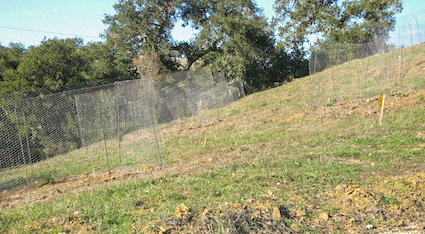
Just after the initial planting of the resource islands. The plants are too small to see. We used a pre-emergent herbicide within the islands and then put down bark mulch to try to keep the grass out of the islands. That was reasonably successful but required some weeding every spring for several years until the plants were decent sized. Plants have been added every fall, typically 25-30, concentrating on the islands for the first 3 years and then starting to plant between the islands.
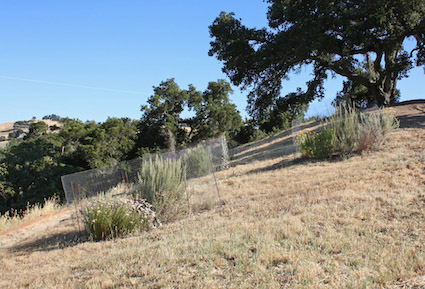
This is Spring 2010, about 18 months since the project started. Many of the initial plants are growing rapidly, and more plants were added to the islands the second year. But the islands are still disconnected, and it will be several years before a combination of reseeding and planting between the islands starts to provide much continuity.
In general, wildflowers didn't do well and died out. We don't really know why, but this hillside really gets baked in the summer. The most successful plants have been those that are most commonly found in chaparral. We started seeing reseeding of coyote brush, California sagebrush, and buckwheat after 7 or 8 years, but there's no sign of reseeding of sticky monkey flower, black sage, or manzanita. Some California plants only germinate from seed after fires.
The area below the house – the first photo above – was not started until several years later. Some of the initial plants were nursery plants, but the majority are coyote brush and California sagebrush that had sprouted elsewhere from reseeding. We dig them up in the late fall about the time the rains start, dig a new hole down the hill, stick the little plant in, dump a gallon of water on it, and then it's on its own. The success rate of this quite crude transplantation process has been remarkably good – better than 50%.
Plant List
Plants that have done well are:
- Coyote brush (Baccharis pilularis)
- California sagebrush (Artemisia californica)
- California buckwheat (Erigonum foliolosum fasciculatum)
- Manzanita (several)
- Sticky monkeyflower (Displacus aurantiacus)
- Golden yarrow (Eriophyllum confertiflorum)
- Fuschia-flowering gooseberry (Ribes speciosum)
- Hummingbird sage (Salvia spathacea)
- Black sage (Salvia mellifera)
- Cleveland sage (Salvia clevelandii)
- Purple sage (Salvia leucophylla)
- Evergreen current (Ribes viburnifolium)
- Pink chaparral current (Ribes malvaceum)
- Bush lupine (Lupinas albifrons)
- Wooly blue curls (Trichostema lanatum)
- Mountain mahogany (Cerocarpus betuloides)
- Toyon ( Heteromeles arbutifolia)
Plants that we've tried but have not done well include:
- Coffeeberry
- Oaks in 1 gallon containers
- Penstomen
- Ceanothus
- Blue-eyed grass
- California fuchia
Regardless of the specific plants, restoration is a long-term project. Our experience suggests that it takes at least 10 years, with new plantings each year, to begin to see results that look reasonably good and where the landscape is likely to sustain itself without our intervention.
Fire
Many California homeowners don't plant native chaparral plants, or even remove chaparral, for fear of fire. Fire is a very real concern in California, but well-maintained chaparral is not the culprit. Before the arrival of the Spanish, most chaparral burned every few decades from lightning-started fires and fires set by the Native Americans. California's native plants are fire-adapted, and some even need the heat of a fire for seeds to germinate. The first winter rains after a fire bring a profusion of wildflowers, and within a few years it takes a trained eye to recognize that a fire had happened. In short, fire renews the California landscape, especially chaparral, as long as it doesn't recur too often.
Many of the horrifying TV images of California fires are due not to chaparral but to non-native plants. The invasive annual grasses are nothing but dry tinder after they die back in the summer, and fire races through grass-covered hillsides. Eucalyptus trees, another non-native species, virtually explode in fires because of their high oil content. Surprisingly, many of the native plants don't burn especially well – they are hard to ignite, and they don't burn quickly.
An issue with native chaparral plants, though, is the build-up of dead branches as the years go by since the last fire. It's the profusion of dead branches that helps power a chaparral fire when one gets started. The take-away for homeowners is that native plants are not a significant fire hazard – less so than uncut annual grasses – if some annual maintenance is done to prevent the build up of dead branches.
Our Native Wildlife
We are fortunate to live in what is virtually a wildlife park. The coastal mountains of Central California have never seen much development or intensive agriculture, and cattle ranching has been sparse, so most of the original wildlife – except for grizzly bears! – has survived. And only a couple of miles of undeveloped oak forests separate us from Las Padres National Forest, a haven for wildlife.
About 30 species of birds are seen around our house on a regular basis. Red-tailed hawks are common, and other raptors are seen on occasion. Ground birds, like quail and towhees, love the restored chaparral, and California quail can almost always be seen nearby. We have an owl box that is used by barn owls every year. Wild turkey stroll through from time to time, although we just as soon they not as they make a huge mess pooping in the fountain.
A herd of about 15 mule deer, also called black-tailed deer, live around us. In the fall, when other food gets scarce, they come onto the patio to eat our container plants and peer in the windows. (The cats don't seem to care.) They've been found sleeping on the shaded porch on hot summer days. They would walk in if we left the door open.
Coyotes and bobcats are seen on occasion, although less often now than when we first moved here. Bobcats have been observed walking across the patio and drinking from our fountain. They're not greatly perturbed by humans and have the same "Don't bug me" attitude as a house cat. Red and gray foxes have also been seen very close to the house, although these are rare.
On at least one occasion – as documented in the photo below – a cougar (also called a mountain lion, a puma, or a panther) walked along our drive, just below the bedroom, in the middle of the night. Cougars are reported in this area fairly often, but they are secretive, nocturnal, and rarely seen.
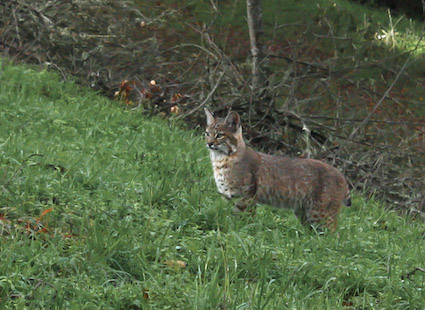
A visiting bobcat.
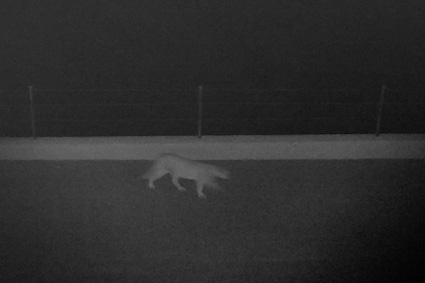
This is not an award-winning photo, but it is an infrared photo from a wildlife camera on our balcony of a cougar walking along the drive in the middle of the night.
© 2021 Randy Knight
